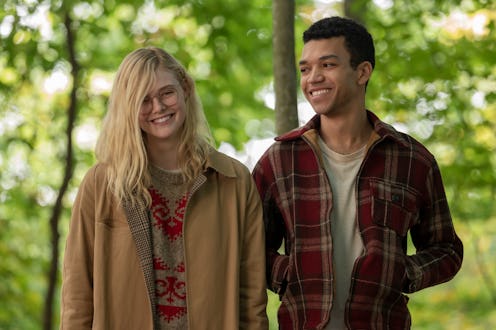Entertainment
The Differences Between The 'All The Bright Places' Book & Movie, Explained

Content warning: This article contains information about suicide, which some might find triggering. This article also contains spoilers for All the Bright Places. Jennifer Niven's 2015 young adult novel All the Bright Places was lauded as a gripping story about teenagers struggling with mental illness. The YA book has now been adapted for film, premiering on Netflix on Feb. 28. As is the case with any film adaptation of popular books, some changes had to be made to ensure a more cinematic experience. With that said, here's our rundown of the differences between the All the Bright Places movie and book.
In All the Bright Places, Violet (Elle Fanning) struggles with survivor's guilt stemming from a car accident that resulted in the death of her sister. That accident leads her to where we find her at the beginning of the film and the book: standing on a ledge overlooking a large drop at the site of her car accident. That's also where she meets Finch (Justice Smith), another person struggling with his own mental illnesses. He talks her down from the ledge, and from there, the two become more and more intertwined. Eventually, they embark on a "wandering project" for school, documenting and exploring various sites in their home state of Indiana. The time they spend together helps their relationship grow from acquaintances to friends to romantic partners, with Finch slowly but steadily helping Violet process her feelings about her own grief.
The movie and the book are mostly aligned, though there are a few differing points. Violet isn't presented as a former "popular girl," so to speak, though she is withdrawn and incredibly introverted, and Violet and Finch's first meeting isn't on a bridge, as in the film, but at the top of a bell tower. Plus, most of the film is presented through Violet's perspective, with a bit of insight as to Finch's own struggles with his mental illness. But as Violet begins to cope and find a way through her own grief, Finch spirals after making a mistake that gets Violet in trouble with her parents.
In the book, Finch has a suicide attempt shortly after the incident, but survives. But in the film, he instead enters into a long downward spiral. He isolates himself, refuses to go to school, gets into a fight, and tries to figure himself out. He visits a support group and then tries to connect with his sister to talk about his abusive father. Ultimately, however, just like in the book, Finch vanishes again for the last time after getting into an argument with Violet.
In the book, after Finch vanishes, Violet searches for him. She receives mysterious texts from him — the significance of which she finds out only a month later — after Finch sends a goodbye letter to Violet and his friends. He had been texting her from the locations they still had left to visit for their school project. From that, she figures out that she might be able to find Finch at the Blue Hole, a large lake they had both already visited. In the film, however, Violet thinks to check the Blue Hole after confiding in her father that she visited the site of her sister's death, way back at the beginning of the film.
From there, the book and the movie more or less fall back into alignment, with Violet returning to the Blue Hole only to find Finch's van and his belongings left on shore, indicating that that Finch died by suicide. At the conclusion of the story, Violet, now struggling with guilt about Finch's death, visits the final location he had teased to her earlier in the story: a chapel for travelers, designed as a refuge for wanderers and a rest stop for people on the road. There, she finds a guestbook with a message from Finch, who had visited some time before.
The film ends with Violet swimming in the Blue Hole again, as a voice over from her class project presentation plays. The book, instead, has Violet finding a song Finch had written for her, which ultimately helps her find healing in the wake of his death.
While there were some minor changes, the only thing that Nivens was against changing was the ending itself. Back in 2019, the author and co-writer of the film told WHSmith, "I never questioned how All the Bright Places would end. I knew in my bones that the only ending could be the one I wrote, not just because too many stories about teen mental health are tied up in neat little packages with bows on top, but because it’s the ending I lived with the real-life Finch. It was the story I knew."